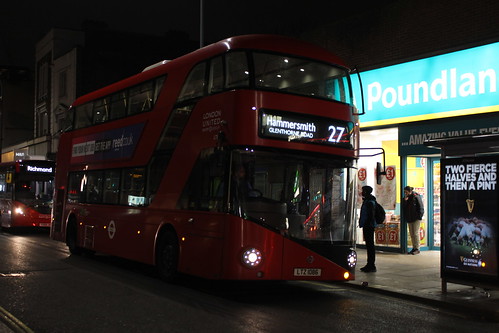
DE20080 passing Chiswick Park Station on the last day of this 440 routing.
(© Aubrey Morandarte)
Route 440 has been rerouted between Bollo Lane Level Crossings and Turnham Green, running via Chiswick Business Park, Chiswick High Road, Oxford Road North, Wellesley Road to terminate at Turnham Green Church. This involves running the route in reverse along Wellesley Road/Oxford Road North, and leaves two notable places unserved by buses. Chiswick Park Station is one of the places that are affected, with the sole bus route running in front of it being rerouted away from it. Chiswick High Road buses from Turnham Green, and the 94 from Acton Green are however 5 minutes away.
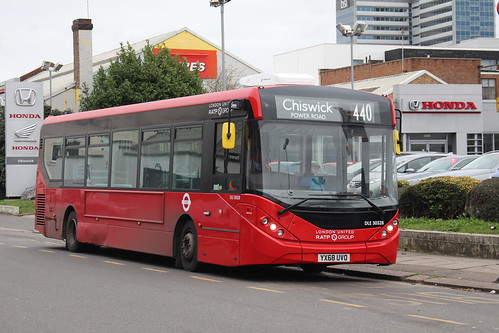
DLE30238 in the last week of 440 serving Power Road.
(© Aubrey Morandarte)
The other part of the route being left unserved by buses is the barely utilised Power Road stand just off Chiswick Roundabout. Notably, Power Road is where W. Chump and Sons, producers of The Grand Tour are based. It is surrounded by smaller offices and a Citroen dealership.
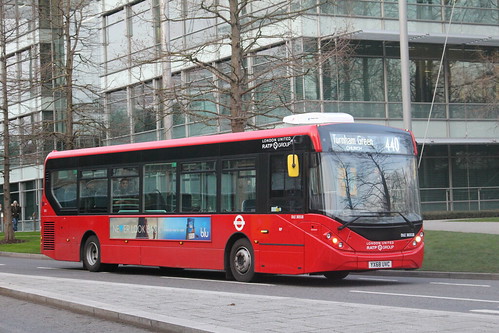
DLE30318 exits Chiswick Business Park on the new routing
(© Aubrey Morandarte)
The new routing means that the 440 serves Gunnersbury Station, finally giving Chiswick Business Park a link to Gunnersbury Station that does not involve significant walking. The route towards Turnham Green does not serve Gunnersbury Station as the bus stop is in front of the turn from Chiswick Business Park. However some drivers unofficially stop outside the station, at the forward end of the bus stop on Chiswick High Road.

DLE303022 stands at Turnham Green
(© Aubrey Morandarte)
The stand at Turnham Green is not new to the route, having stood there between 2007 and 2010 when the route was withdrawn from Stamford Brook Garage, but prior to the reroute of the H91 via Chiswick High Road (and 440 extension to Power Road).
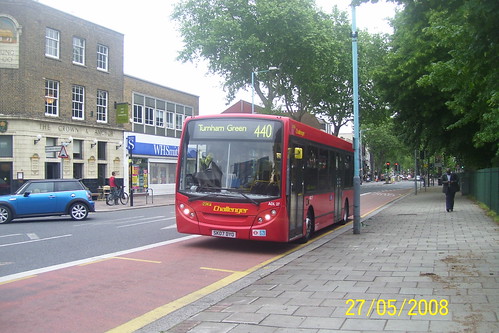
ADL27 from NCP days at Turnham Green in 2008
(© Aubrey Morandarte)
The changes to the 440 are to mask a PVR decrease and shortening of Route 27 to Hammersmith (including night service). The withdrawn section of Route 440 is replaced by walking, including a new bridge from Chiswick Business Park to Chiswick Park LU Station.

ADH45028 passing under the bridge which partly replaces the 27 and 440
(© Aubrey Morandarte)
The new bridge links the business park with Chiswick Park Station, giving relief to Gunnersbury Station. This section of the 27 is rarely used, as most people get on the 27 at Turnham Green Church onwards. The section of the route is not heavily used, but used well enough and relieves the 267 and H91 trunk routes going into Hammersmith along Chiswick High Road.
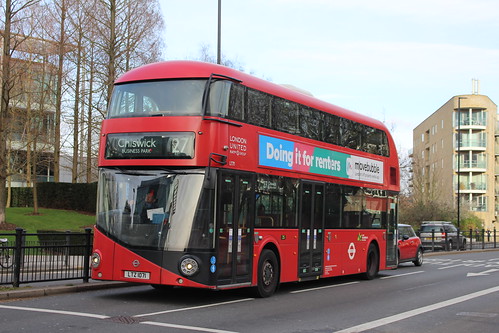
An empty LT71 at Gunnersbury Station
(© Aubrey Morandarte)
The one notable omission since the start of the 27 extension, which has doomed it to be empty is that it touches, but misses Gunnersbury Station due to a lack of bus stop. Plans for a bus stop within the southern end of the Business Park to serve the station fell through, thus the 27 missed a major traffic destination as the Gunnersbury Station bus stops are at the wrong side of the Business Park entrance for the 27 to serve.

A trio of LTs on the last day of the 27 to Chiswick Business Park, from the bridge to Chiswick Park Station
(© Aubrey Morandarte)
The 27 gained LTs from the 10, a notable route loss as it was withdrawn and replaced by the 23...which is barely used in comparison to the 9 between Hyde Park and Hammersmith. However, the amount of LTs from the 10 did not correlate with the PVR of the 27, thus the 27 had odd Enviro 400Hs still when the route was converted to LT.
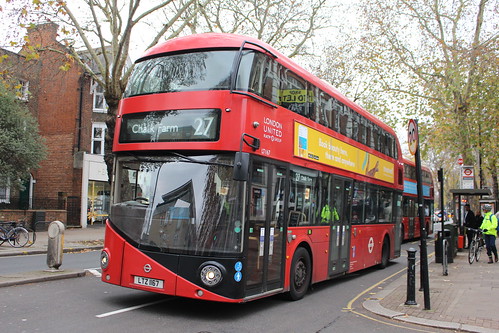
LT167 on Chiswick High Road, no longer served by the route
(© Aubrey Morandarte)
The consultation for the route cut had a massive 72% disapproval rate, with most notable responses including the cut of links between Chiswick and Kensington/Notting Hill Gate (still served by the 94) and some even noting that the cut was to reduce the traffic effect when CS9 is built through Chiswick High Road. It is deemed that approximately 1200 people will be required to change between buses at Hammersmith Bus Station.
Local people were very notable in their opposition, even resorting to anonymous posters against the cut back whilst the consultation was running. Unfortunately, the large level of local opposition did not result in the cut being cancelled, and it went ahead on 9th March 2019.
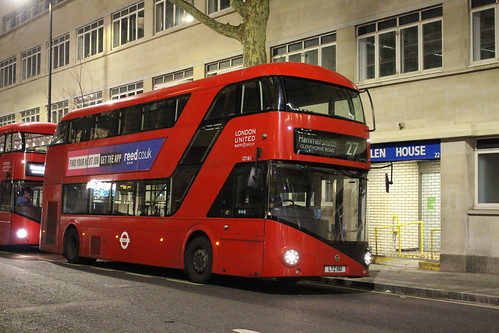
LT161 at the new stand at Glenthorne House
(© Aubrey Morandarte)
The 27 now runs from Hammersmith Town Hall via Studland Street and Glenthorne Road to terminate at Glenthorne House. According to the TfL consultation, the rerouting "create[s] a short new local link from King Street to Glenthorne Road and Hammersmith Grove" which is usually dealt with by walking, and is seldom used so far. The only reason why the route terminates at the old 267 and H91 stand at Hammersmith is because the planned 266 stand at Beadon Road is now occupied by urban roadside gardens, and Hammersmith Bus Station has a lack of stand space, officially.
Talking of which, the information at stands in Hammersmith Bus Station for the 27 change have been abysmally wrong, as such that whiteboards by the local staff have had to be used to portray information. This is the same TfL that had 10 tiles at Hammersmith well into 2019, even though the route was withdrawn in 2018.
Transport for London are responsible for bus stop information. A week before the change was to happen, the tiles at Hammersmith Bus Station were changed. This stop is for the 27 towards Hammersmith Grove. Clearly the information is completely incorrect, as both the 27 and the new N27 are shown as heading towards Chalk Farm at this stop.
 Midway through the week, on one side, the 27 line of destinations were covered, and, for some reason, the destination of "Kensington High Street" on the 23 at the eastbound stop was covered. However, the N27 tile is still uncovered, even though the N27 does not serve this stop. The N27 terminates where the 9/23 terminates, and starts where they start, unofficially. However, iBus differs, and states it terminates at Stop B, to provide the connection with the N9/N11 at the same stop.
Midway through the week, on one side, the 27 line of destinations were covered, and, for some reason, the destination of "Kensington High Street" on the 23 at the eastbound stop was covered. However, the N27 tile is still uncovered, even though the N27 does not serve this stop. The N27 terminates where the 9/23 terminates, and starts where they start, unofficially. However, iBus differs, and states it terminates at Stop B, to provide the connection with the N9/N11 at the same stop.
Above are the whiteboard notices in each direction for the 27. To show how poor the information and publicity there is for the 27 cut, as well as how popular the 27 was from Hammersmith to Chiswick, it required large notices at Hammersmith. Some passengers at the Chiswick end were unaware, as the notices for the cut were only A4 sized small, thus not very easy to notice.
Spider maps in Hammersmith Bus Station for the 27 have the Chiswick Business Park element removed by marker pen.
LT86 on King Street post-curtailment
(© Aubrey Morandarte)
The section west of the bus station until Hammersmith Town Hall is still used to an extent as it serves bus stops that were useful for patrons on the 27. Overall, the execution of this truncation is poor, and even to the extent where 27 tiles were removed on the two stops on Hammersmith Grove towards the terminus.
At night, the route is truncated even further, to Hammersmith Bus Station. As the 9 does not use their stands in the bus station as it runs as N9 to Heathrow, the new N27 uses those stands. Thus, the route runs only to Hammersmith, and thus Chiswick Business Park loses its night service, and the frequency of night buses on Chiswick High Road decreases to the sole 3 buses per hour by the N9.
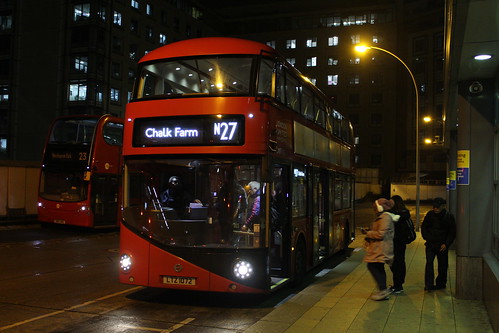
LT72 starting its journey on the first night towards Chalk Farm
(© Aubrey Morandarte)
This is one of the first instances where the night route is shorter than the corresponding day route, as the N27 terminates at the bus station.
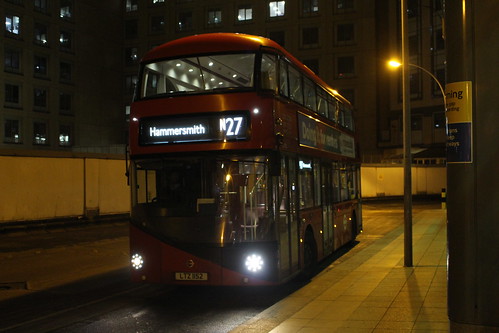
LT152 terminating at Hammersmith
(© Aubrey Morandarte)
Under the most audacious of circumstances, London has a new night route born out of an old 24 hour route. Although Transport for London think this is a more effective deployment of resources, the tangible links broken and the effect of the cuts are irreversible. As Transport for London are undergoing a funding crisis, with many corners cut and larger projects being over budget, these small cuts all add up in their account books.
Post by Aubrey Morandarte
All rights reserved © WLTMTB 2019




